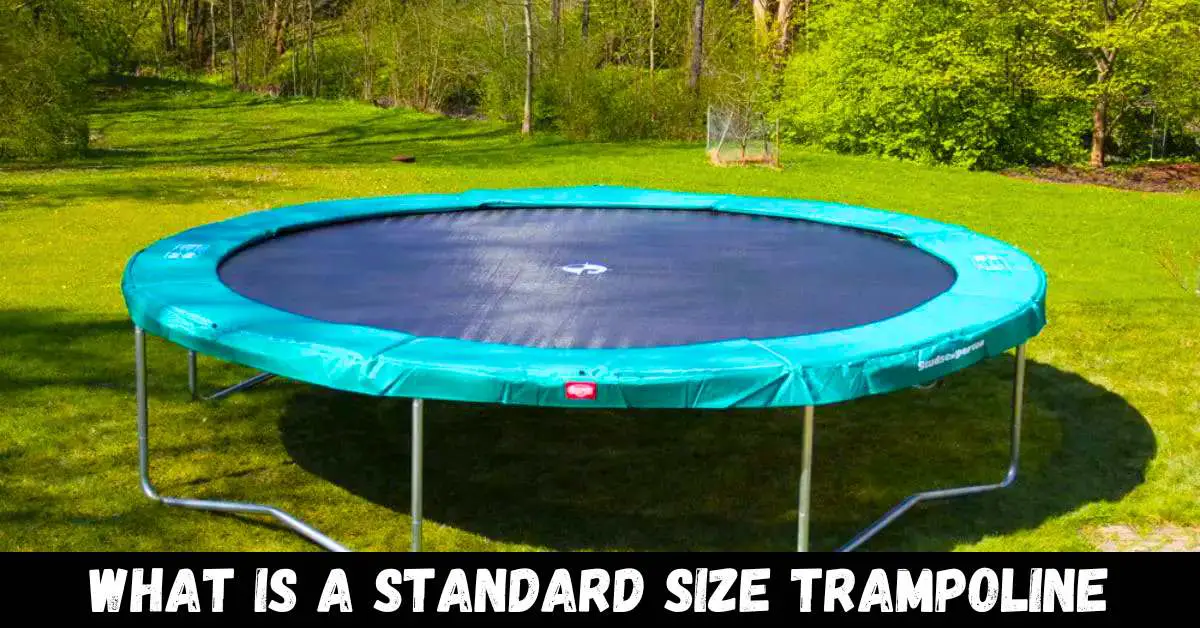I can tell you that a standard size trampoline typically has a diameter ranging from 10 to 15 feet, with a frame height of about 2 to 3 feet. The weight capacity of a standard trampoline can vary, but it usually ranges from 200 to 400 pounds, depending on the model and manufacturer.
Standard trampolines usually come with a set number of springs, typically ranging from 72 to 108, and these springs are usually around 7 to 10 inches in length.
Additionally, a safety enclosure is often included in standard trampolines, which consists of a netting system surrounding the jumping area to prevent users from falling off the trampoline while bouncing.
One of the key advantages of a standard size trampoline is that it is designed to meet industry standards for safety and performance. They are widely available and commonly used in residential backyards and commercial trampoline parks alike.
When using a standard size trampoline, it’s important to follow the manufacturer’s guidelines for installation, weight capacity, and safety precautions to ensure safe and enjoyable bouncing experiences.
Standard-size trampolines provide a balance between size, performance, and safety, making them a popular choice for trampoline enthusiasts of all ages.
In this article, we will discuss in detail what is a standard-size trampoline.
What is a Standard Size Trampoline: A standard size trampoline typically has a diameter of 10 to 15 feet, a weight capacity of 200 to 400 pounds, and includes a safety enclosure.
How are Trampolines Typically Measured?
To measure the size of a trampoline, simply measure the frame from one side to the other, which is known as the diameter. You can use a tape measure and measure across the center of the trampoline, making sure to get consistent measurements from different directions.
Keep in mind that the size of the trampoline includes both the jumping surface and the springs/safety mats.
What is the recommended space requirement for setting up a trampoline?

According to Springfree, a trampoline brand, it is recommended to have a clearance space of 1.5 meters (5 feet) on all sides of the trampoline. So, for a round 10-foot (3-meter) trampoline, you would need a space that is 6 meters (20 feet) long and 6 meters (20 feet) wide.
It’s important to place the trampoline away from any obstacles, such as buildings or fences, to avoid potential injuries.
What is a Standard Size Trampoline? Short Guide
Trampolines that are 10 feet in size are generally considered small to medium, while 12-foot trampolines are considered medium to large. These sizes are commonly chosen by families as they provide a good balance between size and space in the backyard.
What factors should be considered when determining the appropriate size of a trampoline to buy?
When it comes to trampoline sizes, there are no strict rules based on age. However, if your kids want to do tricks or have multiple jumpers at once, a larger trampoline like a 12ft or 14ft may be beneficial. Keep in mind that bigger trampolines can be more expensive and take up more space.
According to Australian trampoline brand Vuly, their medium-sized (10ft) trampolines are suitable for families with slightly older children (6-10 years old) as they provide enough space for users of all skill levels, including both children and adults.
Vuly also mentions that this size is suitable for the average Australian backyard.
What are the differences between Springless and Spring Trampolines?
One thing to keep in mind is that on springless trampolines, the jumping surface is usually larger compared to traditional trampolines. This is because the springs and frame are located underneath the jumping mat.
Instead of regular springs, springless trampolines use different mechanisms such as heavy-duty elastic straps, flexible composite rods, or leaf springs. These designs are considered safer for children as there are no springs for them to accidentally touch or land on.
Common Trampoline Sizes
Trampoline Sizes for Different Backyards and Users
- 8 – 10 Ft Round Trampoline: Ideal for small backyards.
- 12-ft Round Trampoline: Considered medium-sized trampolines.
- 14 Ft Round Trampoline or larger: Provides more flexibility and is suitable for older users.
Trampoline Sizes and Cost Guide
Now that you have decided on the size of trampoline you want to buy, it’s important to consider the price. Trampoline prices are influenced by various factors, including size and quality.
Larger trampolines tend to be more expensive due to the additional materials and parts required. Quality is another important factor that can affect the price, as trampolines made with higher-quality materials and construction may cost more.
Size and Quality Impact Trampoline Prices
Trampoline prices vary depending on size, quality, and type. Smaller trampolines for exercises may start at around $200, but they may not be of good quality. A standard 12-foot trampoline from a reputable brand can cost around $300 to $400.
Larger trampolines, such as 15-foot ones, can cost over $500. Specialty trampolines like rectangles or long trampolines may also cost more due to their unique features.
What is the height of a trampoline?
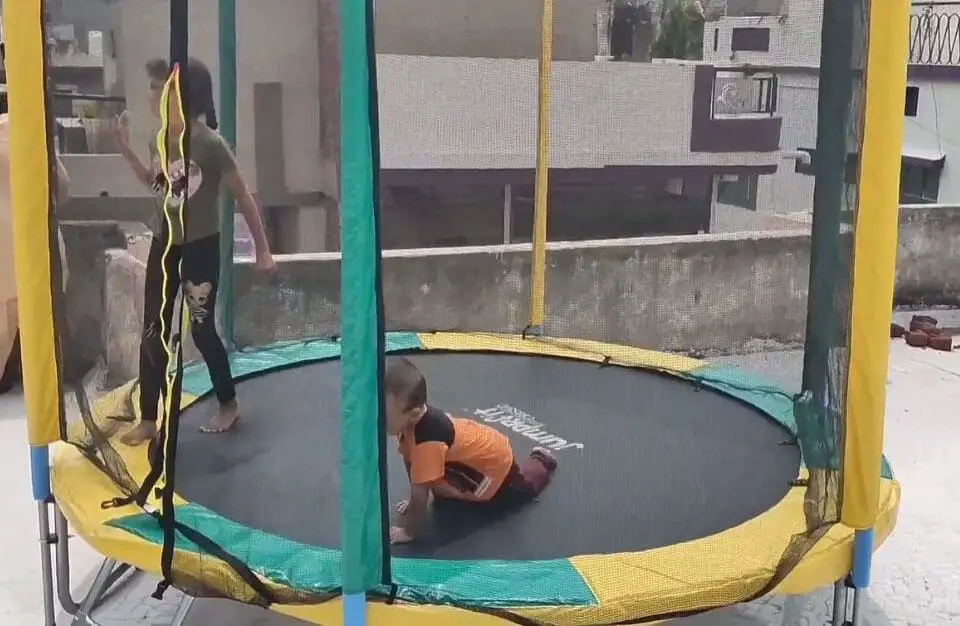
How high is a trampoline from the ground? Generally, small trampolines (6 to 8 ft) have a height of around 2 ft from the ground, while larger trampolines are typically around 3 ft in height.
The total height of a trampoline, including the safety enclosure net, can range from 6 to 8 ft for small trampolines.
Understanding the Dimensions of Olympic Trampolines
According to the International Gymnastics Federation (FIG), the official size of an Olympic trampoline is approximately 16.5682 feet in length, 9.54724 feet in width, and 3.78937 feet in height (or 5 meters by 3 meters by 1.15 meters).
This site is also adopted by USA Gymnastics as the standard. Many trampoline manufacturers produce trampolines with dimensions of 17 feet by 10 feet, which are commonly used for gymnastics purposes.
Differences Between Round and Rectangular Trampolines
Choosing Between Round and Rectangular Trampolines: Understanding the Differences”
Round trampolines are more common and affordable. They are designed to direct the jumper back towards the center, which is considered safer but can sometimes result in collisions between jumpers.
On the other hand, rectangular trampolines provide a higher bounce due to multiple sweet spots on the surface, allowing for maximum bounce.
Selecting the Ideal Trampoline Size for Gymnastics Training
For gymnastics training, it is recommended to select a trampoline size that closely matches the dimensions of an Olympic trampoline, such as 10 feet by 17 feet.
However, if budget constraints or yard size limitations exist, selecting a size that comes as close as possible to the ideal dimensions is recommended.
What is the Appropriate Trampoline Size for Children Age 13 and Below?
If you’re looking for the right trampoline size for your kids, consider the following recommendations:
- For 3-year-olds, a trampoline with a diameter of 36 inches and handles is recommended.
- For 5-year-olds, a trampoline with a diameter of 7 feet is recommended.
- For 10-year-olds, trampolines ranging from 10 to 12 feet in diameter are recommended.
- For children 12 years and older, trampolines with a diameter of 12 feet or larger are recommended.
- For 13-year-olds, trampolines with a diameter of 12 feet or larger are also recommended.
What are the Different Sizes of Trampolines Available?
Trampolines come in various sizes, ranging from small ones for kids, such as 36″, 38″, 40″, 48″, 55″, 3 feet, and 7 feet, which are usually for indoor use. Mini trampolines or rebounders for adults generally come in sizes like 32″, 36″, 38″, 40″, and 49″.
Outdoor trampolines are available in sizes like 6ft, 7ft, 8ft, 10ft, 12ft, 14ft, 15ft, 16ft, and 17ft, which are typically larger and used outdoors.
AlleyOop Trampoline:

AlleyOop offers trampolines that are of average size, but they may be priced higher compared to other brands. However, they are worth considering because they come with double-bounce technology that enhances safety.
Additionally, AlleyOop offers larger trampolines and long rectangle trampolines, which may not be available in some other brands.
Skywalker Trampoline:
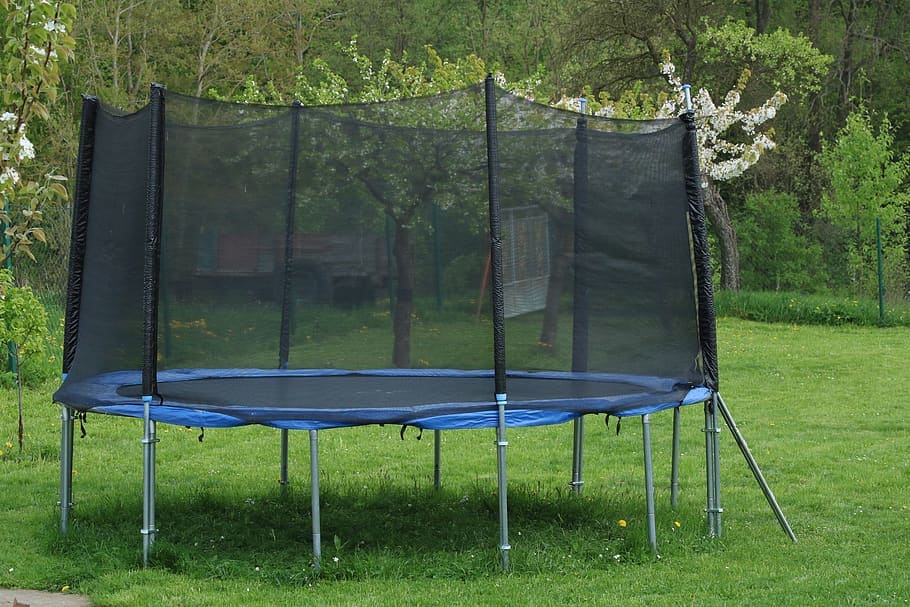
Skywalker trampolines are a great option for beginners. They offer standard trampoline sizes and are priced slightly below average compared to other brands in the same size range.
However, this doesn’t mean their quality is compromised.
One cool feature of Skywalker trampolines is that they offer models with a basketball goal, adding an extra element of fun to your trampoline experience.
Pure Fun Trampoline:
Pure Fun offers affordable trampolines in standard sizes, and their prices are competitive. If you’re not looking for a full-size trampoline, Pure Fun can be a great choice.
They are particularly known for their kids’ trampolines, and we have a guide available to help you make the best decision for your kids.
The Ultega Jumper Trampoline:
If you’re on a budget and looking for a quality trampoline, Ultega Jumper could be a good option. They offer affordable trampolines without compromising on quality. Despite their lower prices compared to other brands, Ultega trampolines are still durable and built to last.
JumpSport Trampoline:
JumpSport trampolines may be more expensive due to their advanced stage bounce technology, which provides a softer bounce that is gentle on joints. If you have joint issues and can afford to spend a little extra, it may be worth it.
JumpSport also offers a variety of trampoline accessories and fitness trampolines, making it a good choice if you’re looking for those options.
what is the biggest size trampoline
The Goliath: The World’s Largest Trampoline in 16×24 Size
The largest trampoline size currently available is the 16×24 Goliath, which is recognized as the world’s largest trampoline. With a massive surface area of 16 feet by 24 feet, the Goliath trampoline offers an unparalleled bouncing experience for those who seek ultimate fun and excitement.
It is designed with a sturdy and durable frame, making it suitable for both recreational use and professional training purposes. The Goliath trampoline boasts features such as a massive size that can accommodate multiple jumpers, durable construction, and high bounce performance.
If you’re looking for the biggest trampoline size to elevate your bouncing experience to new heights, the 16×24 Goliath is the one to consider.
What Size Trampoline for 3 Kids
Selecting the perfect trampoline size for three kids depends on their age, total weight, and the games they may play on it. In general, a 14 FT trampoline is recommended as it provides enough space for three kids to jump comfortably without feeling too crowded or empty.
However, if you want more room for games like Burn Wars or dead man rise, a 15 FT trampoline may be a better option. It is also suitable for families with older children who have reached youth-level physical development.
Are 12 FT Trampolines Adequate for Three Kids?
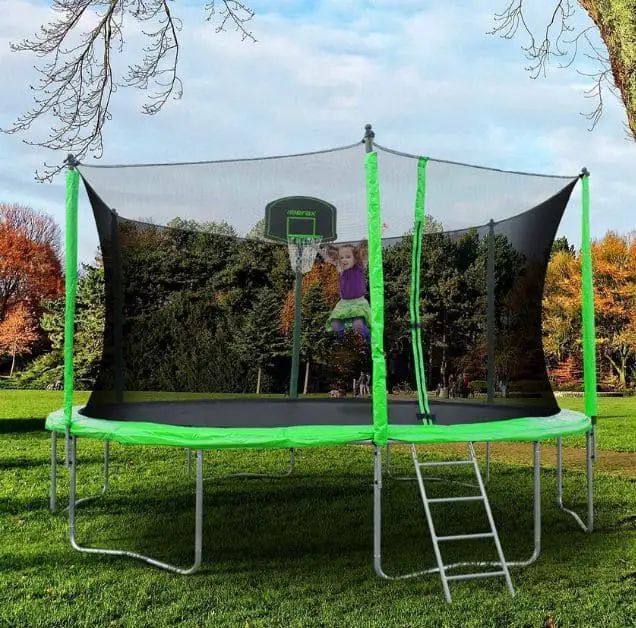
If you have only one or two children using the trampoline at a time, a 12 FT Trampoline can still be big enough for 3 kids. 12 FT Trampolines are also quite popular.
However, if you want to avoid any potential conflicts over playing time, it’s recommended to choose a 14 FT or 15 FT Trampoline.
A 14 FT Trampoline is usually sufficient for 3 kids, while a 15 FT Trampoline is a worry-free option!
Are 14 FT Trampolines Spacious Enough for Three Kids?
Indeed, a 14 FT Trampoline is a great option for 3 kids to play on. In some cases, it may even accommodate up to 5 kids playing without flipping. It’s generally large enough to handle the weight of kids as they grow, making it a suitable choice for families with three children.
Are 15 FT Trampolines Large Enough for Three Kids?
Absolutely! 15 FT Trampolines are very popular among families and make excellent choices for families with 3 kids. The larger size provides ample space for multiple jumpers to play without colliding with each other, reducing the risk of accidents.
With a 15 FT Trampoline, your kids can enjoy uninterrupted bouncing fun without getting in each other’s way.
Helpful Tips for Selecting a Trampoline for 3 Kids
When it comes to choosing a trampoline for three kids, there are a few key factors to keep in mind. Here are some helpful tips to guide you in selecting the right trampoline for your family:
- Size matters: Opt for a larger trampoline size, preferably 15 FT or 16 FT, to ensure enough space for three kids to jump together comfortably.
- Invest in a trampoline with enclosure: Safety should be a top priority, especially for families with multiple jumpers. Choose a trampoline with an enclosure to prevent jumpers from falling off or hitting the frame.
- Round trampolines are ideal for family use: Round trampolines are generally safer for multiple users compared to square trampolines, which are better suited for gymnastics practice.
- Supervise young kids: Children below 6 years old should be closely supervised while jumping on a trampoline to ensure their safety.
- Consider mini indoor trampolines for toddlers: Mini indoor trampolines are recommended for toddlers as they provide a safer and more controlled environment for their age group.
Remember to always prioritize safety and size when selecting a trampoline for three kids, and consider the age and developmental stage of the children using it.
What Size Trampoline is Best for Adults
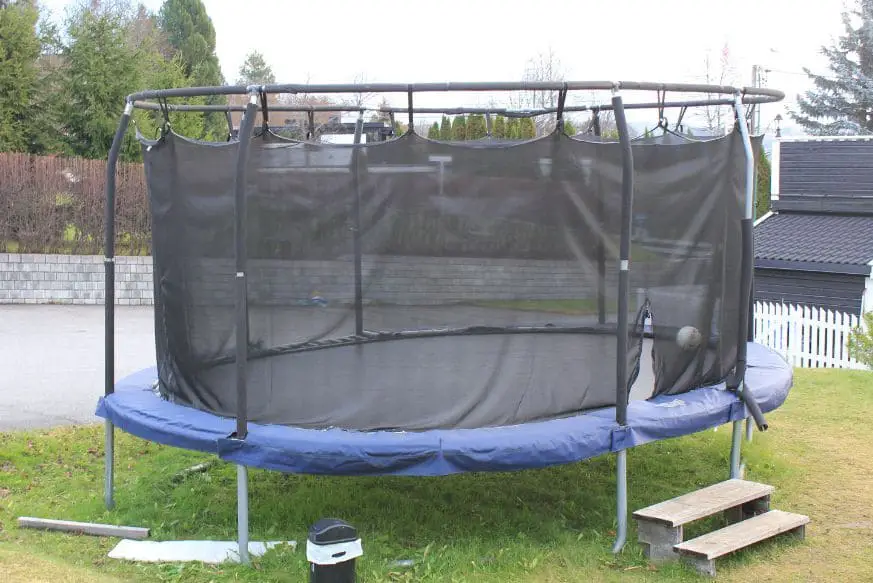
Trampolines are becoming increasingly popular in the United States, not just for children, but also for adults who want to use them for exercise.
Trampolines come in various sizes, such as 40 inches, 45 inches, 48 inches, 55 inches, 8 feet, 10 feet, 12 feet, 15 feet, and more, which can sometimes be confusing.
Trampoline Types for Adult Exercise: A Guide
Trampolines are not just for kids! Adults can also benefit from trampoline exercise as a fun and effective way to stay active and fit. When it comes to selecting the right trampoline for adult exercise, there are various options available on different websites.
Here are some key features to consider when looking for small or large trampolines designed for adult fitness.
Features of Small Adult Fitness Trampolines on Different Websites:
- Indoor Use: Small trampolines are typically designed for indoor use, making them perfect for home workouts or fitness routines in limited spaces.
- Compact Size: Small fitness trampolines are usually compact, ranging from 40 inches to 55 inches in diameter, providing a manageable jumping surface for adult users.
- Sturdy Construction: Look for trampolines with durable frames, strong springs, and quality jumping mats to ensure safety and longevity during your exercise sessions.
- Adjustable Handlebar: Some small trampolines come with adjustable handlebars that provide added stability and support during workouts, especially for those who are new to trampoline exercise.
Features of Large Adult Fitness Trampolines on Different Websites:
- Outdoor Use: Large trampolines are typically designed for outdoor use, providing ample space for jumping and bouncing in open areas.
- Bigger Size: Large fitness trampolines can range from 8 feet to 15 feet or more in diameter, offering a larger jumping surface for more advanced exercises or multiple users.
- Heavy-Duty Construction: Look for trampolines with heavy-duty frames, thick padding, and robust springs that can withstand outdoor weather conditions and heavy use.
- Safety Enclosure: Many large trampolines come with safety enclosures that surround the jumping area to prevent accidents and ensure a safe exercise experience.
- Weight Capacity: Consider the weight capacity of the trampoline to ensure it can accommodate the weight of adult users during vigorous exercise.
Remember to always follow the manufacturer’s guidelines for the safe use and maintenance of your trampoline, regardless of size, to ensure a safe and enjoyable exercise experience.
What is a Normal Size Trampoline: Safety Considerations
A normal-size trampoline can vary depending on the intended use and location (indoor or outdoor). For indoor trampolines, small fitness trampolines usually range from 40 inches to 55 inches in diameter.
For outdoor trampolines, large fitness trampolines can range from 8 feet to 15 feet or more in diameter. However, regardless of the size, safety should always be a top consideration when using a trampoline.
Here are some safety considerations to keep in mind when using a trampoline, regardless of its size:
Enclosure:
Trampolines with safety enclosures, also known as netting or fencing, are highly recommended to prevent users from falling off the trampoline and reduce the risk of injury.
The enclosure should be properly installed, securely attached to the frame, and in good condition, with no holes or tears. It should also be tall enough to prevent users from jumping over it.
Regularly inspect the enclosure for any signs of wear or damage, and replace or repair it as needed to maintain its effectiveness in preventing accidents.
Frame and Springs:
The trampoline frame and springs are critical components that should be inspected regularly for any signs of wear or damage. Ensure that the frame is sturdy and free from cracks or bends and that the springs are intact, with no signs of rust or damage.
Additionally, the frame and springs should be properly covered with padding to reduce the risk of injuries from hard surfaces or sharp edges. Check the padding for any tears or wear, and replace it if necessary to ensure adequate protection for users.
Weight Capacity:
Follow the manufacturer’s weight capacity recommendations at all times to ensure that the trampoline can safely support the weight of all users during jumping and bouncing.
Overloading the trampoline with too much weight can strain the frame and springs, increasing the risk of accidents.
Make sure to consider the weight of all users, including any accessories or additional equipment, and do not exceed the recommended weight capacity to maintain safe trampoline use.
Supervision:
Trampoline use should always be supervised, especially for children, to ensure safe jumping practices and prevent accidents. An adult should always be present to supervise and monitor trampoline activities, ensuring that users follow safety rules and guidelines.
Children should be supervised closely to prevent them from engaging in risky behaviors, such as double bouncing or attempting dangerous stunts.
Jumping Rules:
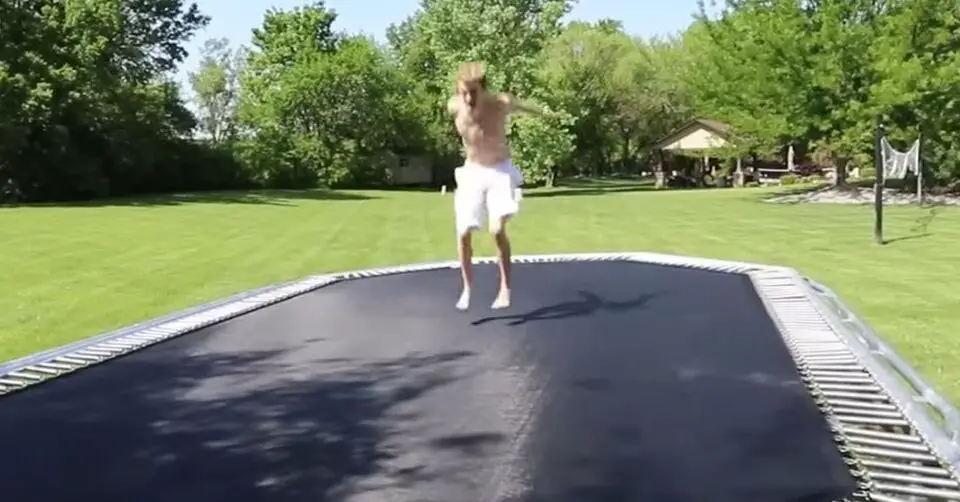
Establish and enforce clear rules for safe jumping on the trampoline. These rules may include no somersaults or flips, no jumping off the trampoline, and allowing only one person to jump at a time.
Make sure that all users are aware of and follow these rules consistently to reduce the risk of injuries from reckless or unsafe jumping practices.
Proper Use:
Use the trampoline only for its intended purpose, which is for jumping and bouncing. Avoid using it as a play area for other activities, such as wrestling or roughhousing, which can increase the risk of injuries.
Users should be instructed to refrain from sitting or lying on the trampoline surface while others are jumping, as this can also be dangerous.
Maintenance:
Regularly inspect and maintain the trampoline to ensure its safe use. This includes checking for loose or damaged parts, such as bolts, screws, or springs, and tightening or replacing them as needed.
Keep the trampoline clean and free from debris, and remove any potential hazards, such as toys or sharp objects, from the jumping area. Regular maintenance and timely repairs can help prevent accidents caused by equipment malfunctions or deterioration.
By diligently following these safety considerations, including ensuring proper enclosure, checking frame and springs, adhering to weight capacity guidelines, providing supervision, establishing jumping rules, promoting proper use, and conducting regular maintenance, you can help create a safe environment for trampoline use and minimize the risk of injuries to users.
Comparison with Non-Standard Trampolines
When it comes to trampolines, there are various non-standard options available in terms of size, shape, and design. These non-standard trampolines may deviate from the traditional round or rectangular shapes commonly seen in standard trampolines.
It’s important to be aware of the differences and considerations associated with non-standard trampolines.
Variations and Deviations from Standard Size Trampolines:
Non-standard trampolines can come in a range of sizes that may differ from the typical dimensions of standard trampolines, such as 8 foot, 10 foot, 12 foot, or 15 foot.
Additionally, non-standard trampolines may have unique shapes, such as oval, hexagonal, octagonal, or other irregular shapes.
These variations in size and shape can impact the safety and performance of the trampoline, and users should be aware of any specific guidelines or instructions provided by the manufacturer for these non-standard trampolines.
Risks and Considerations when using Non-Standard Trampolines:
Using non-standard trampolines may pose additional risks and considerations compared to standard trampolines. For example, non-standard trampolines may have different weight capacities, jumping dynamics, and safety features compared to traditional trampolines.
The unique shape or size of the trampoline may also affect the stability, bounce, and overall safety of the trampoline. It’s important to carefully read and follow the manufacturer’s guidelines for non-standard trampolines to ensure safe and responsible use.
When using non-standard trampolines, it’s crucial to consider the availability of replacement parts, maintenance requirements, and overall durability of the trampoline.
Non-standard trampolines may also have different warranty coverage, which can affect the repair or replacement options in case of any issues.
Proper supervision, adherence to safety rules, and regular maintenance should be followed for non-standard trampolines, just like with standard trampolines, to minimize the risk of injuries and ensure safe enjoyment of the trampoline.
FAQs:
Q:1 What is the standard size for a trampoline?
The standard size for a trampoline can vary depending on the manufacturer, but a typical size for a round trampoline is 10 feet in diameter. However, trampolines also come in various other sizes, including 8 feet, 12 feet, 14 feet, and 15 feet, among others.
It’s important to carefully measure the available space in your yard before purchasing a trampoline to ensure it fits properly and meets any local safety regulations.
Q:2 What are the dimensions of a standard rectangular trampoline?
A standard rectangular trampoline is usually larger than a round trampoline and is commonly available in sizes such as 8 feet by 12 feet, 10 feet by 14 feet, and 14 feet by 16 feet.
The dimensions of a rectangular trampoline may vary slightly depending on the manufacturer, but these sizes are commonly used. Rectangular trampolines are often preferred by athletes and gymnasts due to their higher bounce and larger jumping area.
Q:3 Are there any height restrictions for a standard size trampoline?
Yes, there are height restrictions for trampolines to ensure safety. Most trampolines have a recommended minimum age requirement of 6 years old, and children below this age should not use the trampoline.
Additionally, the height of the jumping surface from the ground should be taken into consideration. The jumping surface of a trampoline is typically around 2 to 3 feet above the ground, depending on the design and brand.
It’s important to follow the manufacturer’s recommendations and local safety guidelines regarding height restrictions for trampolines.
Q:4 What is the weight limit for a standard size trampoline?
The weight limit for a trampoline can vary depending on the size and brand, but most standard-size trampolines have a weight capacity ranging from 200 to 250 pounds.
However, some larger trampolines designed for multiple users or professional use may have higher weight limits.
It’s crucial to adhere to the manufacturer’s weight limit recommendations for the safe use of the trampoline and to prevent accidents or damage to the equipment.
Q:5 What materials are commonly used in a standard size trampoline?
A standard size trampoline typically consists of several components made from different materials. The frame is usually constructed from steel or galvanized steel for durability and stability.
The jumping mat, which is the surface that users bounce on, is typically made from a high-quality woven fabric like polypropylene or polyethylene that is UV resistant and designed to withstand the impact of jumping.
The springs are usually made from steel and are designed to provide the necessary elasticity for the trampoline’s bounce.
Additionally, trampolines may have safety padding made from foam and covered with PVC or other durable materials to cover the springs and frame to reduce the risk of injuries.
Q:6 What are the safety features of a standard size trampoline?
A standard size trampoline typically includes several safety features to minimize the risk of accidents. These may include safety nets or enclosures, which are designed to keep users within the jumping area and prevent falls off the trampoline.
The jumping mat and springs may also have a protective pad or cover to prevent users from coming into direct contact with the springs or frame. Some trampolines may also have ladder attachments for easy access and padded poles for added safety around the enclosure.
However, it’s important to note that safety features can vary depending on the brand and model, and it’s essential to carefully follow the manufacturer’s instructions and guidelines for safe use.
Q:7 Can a standard size trampoline be used indoors?
In general, trampolines are designed for outdoor use due to their size and the need for open space for safe jumping. Standard-size trampolines are typically larger and may not be suitable for indoor use in most homes due to space limitations and potential property damage.
Indoor trampolines, also known as mini-trampolines, are smaller in size and designed specifically for indoor use. They usually have a smaller jumping area and are used for fitness or recreational purposes rather than high-flying jumps.
It’s important to carefully review the manufacturer’s recommendations and guidelines before using a trampoline indoors to ensure safety and prevent property damage.
Conclusion:
In conclusion, a standard size trampoline can vary in size and shape, with round and rectangular being the most common types.
Round trampolines typically have a diameter of 10 feet, while rectangular trampolines come in various sizes such as 8 feet by 12 feet, 10 feet by 14 feet, and 14 feet by 16 feet.
Trampolines are typically made from durable materials such as steel frames, UV-resistant fabric for the jumping mat, and steel springs for elasticity. Safety features such as enclosures, padding, and ladders may also be included to minimize the risk of accidents.
When using a trampoline, it’s crucial to follow the manufacturer’s recommendations and local safety guidelines, including age and weight restrictions, to ensure safe and responsible use.
Trampolines are designed for outdoor use in open spaces, and indoor trampolines, or mini-trampolines, are available for indoor use in limited spaces.
Carefully measuring the available space in your yard, adhering to weight limits, and using safety features are important considerations for safe trampoline use.
Remember to always supervise children while they are using a trampoline, and instruct them on proper jumping techniques and safety rules. By following safety guidelines and using trampolines responsibly, you can enjoy a fun and exciting experience while minimizing the risk of accidents.
We hope you will be well aware of what is a standard size trampoline. After reading this comprehensive article. If you have any questions, feel free to comment below!

